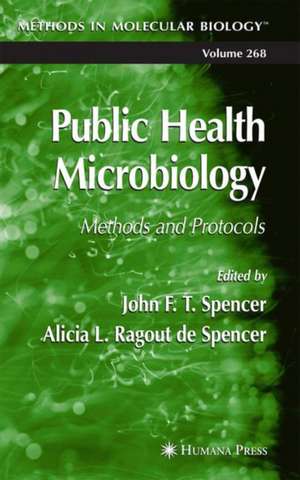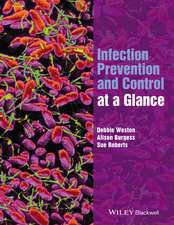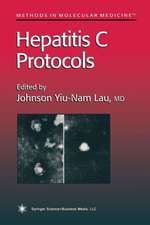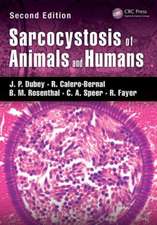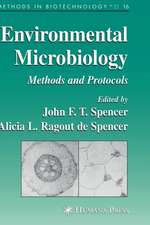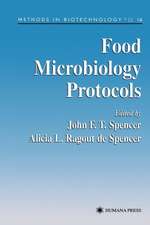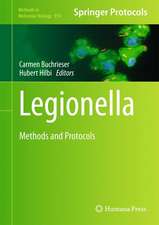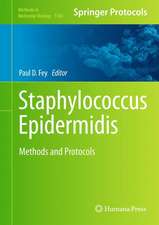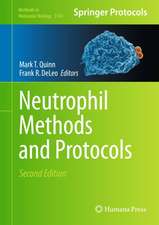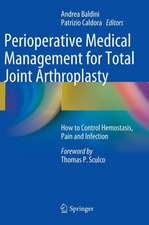Public Health Microbiology: Methods and Protocols: Methods in Molecular Biology, cartea 268
Editat de John F. T. Spencer, Alicia L. Ragout de Spenceren Limba Engleză Hardback – 20 mai 2004
| Toate formatele și edițiile | Preț | Express |
|---|---|---|
| Paperback (1) | 795.09 lei 6-8 săpt. | |
| Humana Press Inc. – 10 noi 2010 | 795.09 lei 6-8 săpt. | |
| Hardback (1) | 1118.94 lei 6-8 săpt. | |
| Humana Press Inc. – 20 mai 2004 | 1118.94 lei 6-8 săpt. |
Din seria Methods in Molecular Biology
- 9%
 Preț: 791.63 lei
Preț: 791.63 lei - 23%
 Preț: 598.58 lei
Preț: 598.58 lei - 20%
 Preț: 882.98 lei
Preț: 882.98 lei -
 Preț: 252.05 lei
Preț: 252.05 lei - 5%
 Preț: 802.70 lei
Preț: 802.70 lei - 5%
 Preț: 729.61 lei
Preț: 729.61 lei - 5%
 Preț: 731.43 lei
Preț: 731.43 lei - 5%
 Preț: 741.30 lei
Preț: 741.30 lei - 5%
 Preț: 747.16 lei
Preț: 747.16 lei - 15%
 Preț: 663.45 lei
Preț: 663.45 lei - 18%
 Preț: 1025.34 lei
Preț: 1025.34 lei - 5%
 Preț: 734.57 lei
Preț: 734.57 lei - 18%
 Preț: 914.20 lei
Preț: 914.20 lei - 15%
 Preț: 664.61 lei
Preț: 664.61 lei - 15%
 Preț: 654.12 lei
Preț: 654.12 lei - 18%
 Preț: 1414.74 lei
Preț: 1414.74 lei - 5%
 Preț: 742.60 lei
Preț: 742.60 lei - 20%
 Preț: 821.65 lei
Preț: 821.65 lei - 18%
 Preț: 972.30 lei
Preț: 972.30 lei - 15%
 Preț: 660.49 lei
Preț: 660.49 lei - 5%
 Preț: 738.41 lei
Preț: 738.41 lei - 18%
 Preț: 984.92 lei
Preț: 984.92 lei - 5%
 Preț: 733.29 lei
Preț: 733.29 lei -
 Preț: 392.60 lei
Preț: 392.60 lei - 5%
 Preț: 746.26 lei
Preț: 746.26 lei - 18%
 Preț: 962.66 lei
Preț: 962.66 lei - 23%
 Preț: 860.22 lei
Preț: 860.22 lei - 15%
 Preț: 652.64 lei
Preț: 652.64 lei - 5%
 Preț: 1055.50 lei
Preț: 1055.50 lei - 23%
 Preț: 883.87 lei
Preț: 883.87 lei - 19%
 Preț: 491.89 lei
Preț: 491.89 lei - 5%
 Preț: 1038.86 lei
Preț: 1038.86 lei - 5%
 Preț: 524.16 lei
Preț: 524.16 lei - 18%
 Preț: 2122.34 lei
Preț: 2122.34 lei - 5%
 Preț: 1299.23 lei
Preț: 1299.23 lei - 5%
 Preț: 1339.12 lei
Preț: 1339.12 lei - 18%
 Preț: 1390.26 lei
Preț: 1390.26 lei - 18%
 Preț: 1395.63 lei
Preț: 1395.63 lei - 18%
 Preț: 1129.65 lei
Preț: 1129.65 lei - 18%
 Preț: 1408.26 lei
Preț: 1408.26 lei - 18%
 Preț: 1124.92 lei
Preț: 1124.92 lei - 18%
 Preț: 966.27 lei
Preț: 966.27 lei - 5%
 Preț: 1299.99 lei
Preț: 1299.99 lei - 5%
 Preț: 1108.51 lei
Preț: 1108.51 lei - 5%
 Preț: 983.76 lei
Preț: 983.76 lei - 5%
 Preț: 728.16 lei
Preț: 728.16 lei - 18%
 Preț: 1118.62 lei
Preț: 1118.62 lei - 18%
 Preț: 955.25 lei
Preț: 955.25 lei - 5%
 Preț: 1035.62 lei
Preț: 1035.62 lei - 18%
 Preț: 1400.35 lei
Preț: 1400.35 lei
Preț: 1118.94 lei
Preț vechi: 1177.84 lei
-5% Nou
Puncte Express: 1678
Preț estimativ în valută:
214.10€ • 223.56$ • 176.80£
214.10€ • 223.56$ • 176.80£
Carte tipărită la comandă
Livrare economică 15-29 aprilie
Preluare comenzi: 021 569.72.76
Specificații
ISBN-13: 9781588291172
ISBN-10: 1588291170
Pagini: 568
Ilustrații: XVII, 548 p.
Dimensiuni: 155 x 235 x 36 mm
Greutate: 1.03 kg
Ediția:2004
Editura: Humana Press Inc.
Colecția Humana
Seria Methods in Molecular Biology
Locul publicării:Totowa, NJ, United States
ISBN-10: 1588291170
Pagini: 568
Ilustrații: XVII, 548 p.
Dimensiuni: 155 x 235 x 36 mm
Greutate: 1.03 kg
Ediția:2004
Editura: Humana Press Inc.
Colecția Humana
Seria Methods in Molecular Biology
Locul publicării:Totowa, NJ, United States
Public țintă
Professional/practitionerCuprins
Bacteria.- Detection of Tetracycline Resistance Genes by PCR Methods.- Integron Analysis and Genetic Mapping of Antimicrobial Resistance Genes in Salmonella enterica serotype Typhimurium.- Molecular-Based Identification and Typing of Campylobacter jejuni and C. coli.- Molecular Genotyping Methods and Computerized Analysis for the Study of Salmonella enterica.- Viruses.- Detection of Infectious Rotaviruses by Flow Cytometry.- Integrated Cell Culture/PCR for Detection of Enteric Viruses in Environmental Samples.- Abundance in Sewage of Bacteriophages Infecting Escherichia coli O157:H7.- Molecular Genotyping of Irish Rotavirus Strains.- Hepatitis A Virus.- Fungi.- Typing Fungal Isolates.- Fungal Isolation and Enumeration in Foods.- Determination of Aflatoxins and Zearalenone in Different Culture Media.- Other Pathogens.- Intracellular Multiplication of Legionella Species and the Influence of Amoebae on Their Intracellular Growth in Human Monocytes.- Viability of Amoebae, Fungal Conidia, and Yeasts.- Detection and Differentiation of Cryptosporidium Oocysts in Water by PCR-RFLP.- Genotyping of Cryptosporidium parvum With Microsatellite Markers.- Immunomagnetic Separation of Pathogenic Organisms From Environmental Matrices.- Detection of Erysipelothrix rhusiopathiae in Clinical and Environmental Samples.- Interaction Between Lactic Acid Bacteria and Gastrointestinal Nematodes of Caprine Origin.- Molecular Detection of Genes Responsible for Cyanobacterial Toxin Production in the Genera Microcystis, Nodularia, and Cylindrospermopsis.- Bacteriocins and Other Inhibitors.- Purification of Antilisterial Bacteriocins.- The Hazard Analysis and Critical Control Point System in Food Safety.- Testing Disinfectants in the Food Factory.- Nontraditional Method of Evaluating Disinfectants.-Microbiological Analysis of Cosmetics.- Helicobacter pylori and Food Products.- Microbiological Test for Sanitation of Equipment in the Food Factory.- Spectrophotometric Determination of Histamine in Fisheries Using an Enzyme Immunoassay Method.- Flavonoids From Argentine Tagetes (Asteraceae) With Antimicrobial Activity.- Purification of Bacteriocins Produced by Lactic Acid Bacteria.- Production of Antimicrobial Substances by Lactic Acid Bacteria I.- Production of Antimicrobial Substances by Lactic Acid Bacteria II.- Statistical Models to Optimize Production of Probiotic Characteristics.- Meat-Model System Development for Antibacterial Activity Determination.- In Vivo Studies in Mice.- Colonization Capability of Lactobacilli and Pathogens in the Respiratory Tract of Mice.- Effects of Estrogen Administration on the Colonization Capability of Lactobacilli and Escherichia coli in the Urinary Tracts of Mice.- Effect of Lactobacilli Administration in the Vaginal Tract of Mice.- Determination of Bacterial Adhesion to Intestinal Mucus.- Animal Model for In Vivo Evaluation of Cholesterol Reduction by Lactic Acid Bacteria.- Assessing Survival of Dairy Propionibacteria in Gastrointestinal Conditions and Adherence to Intestinal Epithelia.- Special Methods.- Bacterial Surface Characteristics Applied to Selection of Probiotic Microorganisms.- Adhesion Ability of Lactobacillus to Vaginal Epithelial Cells.- Hydroxylapatite Beads As an Experimental Model to Study the Adhesion of Lactic Acid Bacteria From the Oral Cavity to Hard Tissues.- Microtechnique for Identification of Lactic Acid Bacteria.- Differentiation of Lactic Acid Bacteria Strains by Postelectrophoretic Detection of Esterases.- Determination of Esterolytic and Lipolytic Activities of Lactic Acid Bacteria.- Meat-Model System Development for Proteolytic Activity Determination.- ?-Glucuronidase Method to Determine Mastitis Levels in Goat Milk.- Differences Between Biogenic Amine Detection by HPLC Methods Using OPA and Dansyl Derivates.- Reviews.- Microflora of the Gastrointestinal Tract.- Public Health Implications Related to Spread of Pathogens in Manure From Livestock and Poultry Operations.- Molecular Aspects of Disease Pathogenesis in the Transmissible Spongiform Encephalopathies.
Recenzii
"...highly recommended for graduate students as well as advanced researchers working in the field of public health microbiology." - International Journal of Hygiene and Environmental Health
Textul de pe ultima copertă
The world abounds with microorganisms that are hazardous to human health in the normal course of life. In Public Health Microbiology: Methods and Protocols, expert investigators describe in step-by-step detail the laboratory techniques they have perfected for determining the nature and character of a diverse group of hazardous bacteria, viruses, and fungi. For bacterial and viral pathogens, the authors give special attention to PCR methods for detecting genes resistant to tetracycline, for resistance in Salmonella enterica, for identifying and typing Campylobacter coli, and for detecting the abundance of enteric, hepatitis A, and rotaviruses in sewage, as well as bacteriophages infecting the O157:H7 strain of Escherichia coli. For fungi the authors offer methods for computerized analysis and typing of fungal isolates, for the isolation and enumeration of fungi in foods, and for the determination of aflatoxin and zearalenone. Other methods deal with hazard analysis, the use of disinfectants, microbiological analysis of cosmetics, microbiological tests for sanitation equipment in factories, and the uses of animals in studies of various characteristics of lactobacilli. Review articles address the spread of pathogens from livestock and poultry production, including the threat of prion-based diseases. All protocols presented follow the successful Methods in Molecular Biology™ series format, each one offering step-by-step laboratory instructions, an introduction outlining the principle behind the technique, lists of equipment and reagents, and tips on troubleshooting and avoiding known pitfalls.
Timely and highly practical, Public Health Microbiology: Methods and Protocols offers researchers and public health specialists alike a wide-ranging collection of methods for the determination of many important pathogenic microorganisms, their effects on health, and possible measures that can be taken to counter these effects.
Timely and highly practical, Public Health Microbiology: Methods and Protocols offers researchers and public health specialists alike a wide-ranging collection of methods for the determination of many important pathogenic microorganisms, their effects on health, and possible measures that can be taken to counter these effects.
Caracteristici
Includes supplementary material: sn.pub/extras
